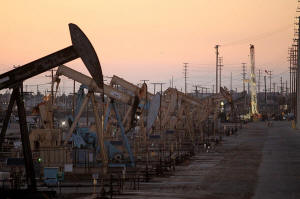|
Brent crude futures fell 39 cents, or 0.5%, to $81.23 a barrel
by 1001 GMT. U.S. West Texas Intermediate crude futures (WTI)
were down 34 cents, or 0.4%, at $76.15.
The dip extended losses registered last week, when Brent lost
about 2% and WTI fell more than 3% on signs that the U.S.
Federal Reserve is in no rush to cut interest rates.
Sentiment appears focused on higher-for-longer interest rate
expectations that lifted the U.S. dollar and pressured commodity
prices, said independent analyst Tina Teng.
A stronger dollar makes oil more expensive for buyers holding
other currencies.
Oil prices have been trading between $70 and $90 a barrel since
November as rising U.S. supply and concern over weak Chinese
demand offset OPEC+ supply cuts despite two wars raging in
Ukraine and Gaza.
As the Israel-Hamas conflict continues in the Middle East, White
House national security adviser Jake Sullivan told CNN on Sunday
that negotiators for the United States, Egypt, Qatar and Israel
had agreed on the basic contours of a hostage deal during talks
in Paris but are still in negotiations.
The geopolitical risk premium on Brent crude from by Yemeni
Houthis on ships in the Red Sea remained modest at only a $2 a
barrel, Goldman Sachs analysts said in a note.
However, the bank has raised its summer peak price projection to
$87 a barrel, up from $85, after Red Sea disruptions have driven
larger than expected draws in stocks held by developed
countries.
Goldman Sachs still expects oil demand to grow by 1.5 million
barrels per day (bpd) in 2024 but has cut its forecast for China
while raising projections for the United States and India.
(Reporting by Noah BrowningAdditional reporting by Florence Tan
in Singapore and Colleen Howe in BeijingEditing by David
Goodman)
[© 2024 Thomson Reuters. All rights
reserved.]
This material may not be published,
broadcast, rewritten or redistributed.
Thompson Reuters is solely responsible for this content.

|
|




